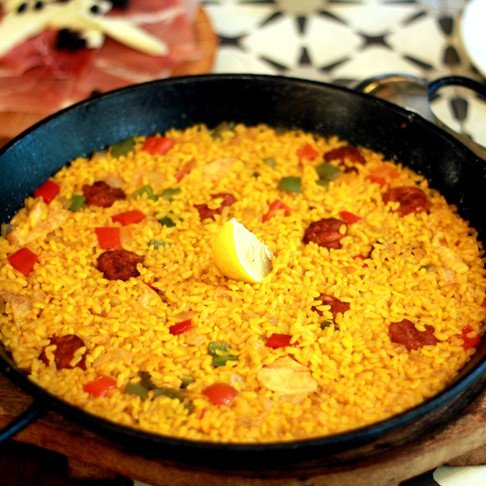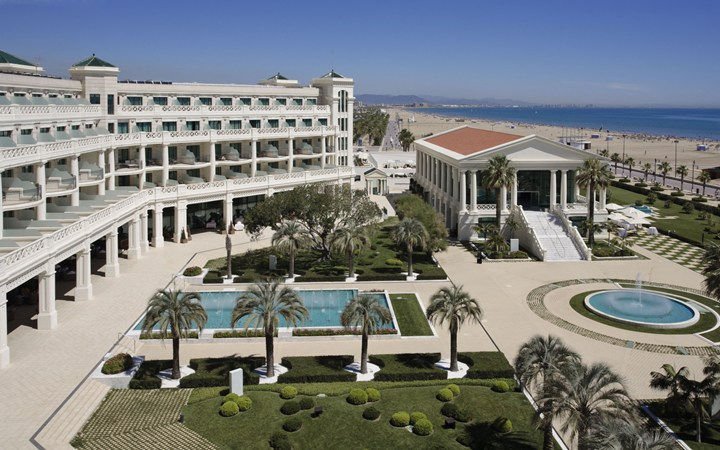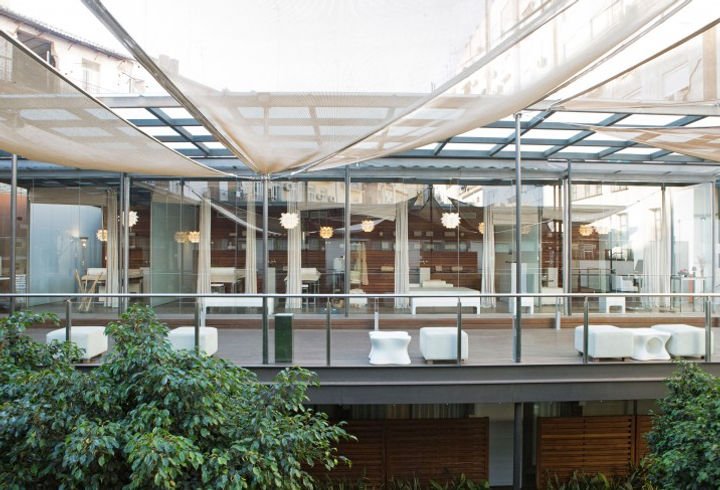Destination Guide: Valencia
Spain's 3rd largest city hides under the radar, despite its population of nearly 1 million. Valencia is bordered on the east by the Mediterranean, divided by the world's greatest urban park (Turia), and surrounded by medieval towns. The Carmen neighborhood still houses two massive stone towers from the wall that once protected it. It is the birthplace of the legendary architect Santiago Calatrava, whose unforgettable structures will make professional photographers out of anyone. With over 300 days of sunshine and a longer beach than Barcelona, it is no wonder that Valencia is becoming one of Europe's cannot miss destinations.
City of Arts and Sciences
Foods to Try
The birthplace of paella fuels its people with its own style of rice and, of course, Jamon. Both of which you can find all over the city. But the best place to experience fresh, local cuisine is Central Market. The Spanish love their meat and cheese, which you will find scattered amongst the fruits and veggies. Spain produces more olive oil than any country, so be sure to try the many different varieties, always extra virgin. The quality of paella varies wildly, and a locally-created website that spotlights this dish is Wikipaella. Other popular dishes are Fiduea, a seafood noodle dish, and Suquet de Peix, an eel, potato, garlic, and fish stew. Be sure not to miss cured sausages like Sobrasada and, of course, Jamon Iberico.
Transportation Options
The terrain is flat, and protected bike lanes are abundant, so the city buzzes with bikes and scooters. Grab a weekly pass for Valenbisi, the local bike share, for about 13 Euros. If you are staying longer, get a year pass for 29 Euros. The bus system is frequent and widespread, so getting around on transit is easy. Buy a pass at any of the tobacco shops, which you will find everywhere. There is a metro system, but the stations serve the suburbs better than downtown connections. Cabs are abundant, so flag one down or download Cabify, the local version of Uber. Nothing is more than a mile away in the old town, so bring your walking shoes and enjoy this city at a slower pace.
Best Time to Visit
It is warm all year round in Valencia, and with 300+ days of sunshine, you cannot go wrong. In the summer, the average high is around 84 °F, and the low is around 70 °F. The cooler temperatures are typically December - February, with highs around 62 °F and lows around 46 °F. Valencia is known for having some of the mildest winters in Europe. It has not snowed since 1960.
What to Do
Turia Park
Aquarium
There is enough here to keep you busy for a week. On the west end, you have Bioparc Valencia, a zoo with naturalistic habitats for animals mostly from Africa. On the east end, you have the City of Arts and Sciences - designed by Santiago Calatrava - consisting of a gorgeous science museum, a music hall, and the best aquarium in Europe, all surrounded by elegant ponds. The remainder of the park has three miles of walking, jogging, and biking paths, plus playgrounds and sports facilities. Finally, travelers with children cannot leave the park without climbing on Gulliver as a giant in the land of Lilliput (Gulliver Park).
Take a paella cooking class
There is no better way to soak up the culture than to make the local dish from scratch. Learn how to manage the fire and cook the rice to perfection by developing those lovely browned bits, called socarrat. Some tours include trips to the local market to buy your ingredients. In addition, you can choose a class that respects vegan or pescatarian diets. Take these skills home and start your own Sunday tradition of cooking paella surrounded by family.
Vermouth and a Snack
Vermouth and tapas crawl through El Carmen
Vermouth and a Snack
The Spanish know it is important to stay fed as you enjoy your tasty beverages. Before dinner, the locals drink vermouth, a fortified wine usually served on ice with an orange slice and olives. El Carmen has dozens of watering holes to start (and finish) your evening. Many locations serve a complimentary tapa with your drink. Look for the sushi-style refrigerators in the bar, filled with single bite combinations of meat, cheese, bread, and veggies.
DIY architecture and history walk
Choose from the churches, Roman ruins, markets, bridges, and museums. Valencia is home to the largest market in Europe (Mercat Central), which sits across from the silk exchange (La Lonja de la Seda). Just outside the old city is the beautiful train station (Estacio del Nord), sitting next to the Roman Colosseum’s updated cousin, a bullring called Placa de Bous. In the bullring is a museum, and you can take a tour of the arena, rarely used for its namesake.
Beach day
Malvarrosa beach is a 15-minute trip from the city, so take a break from the traditional sites and relax. The Mediterranean waters are usually calm, and the sand gently slopes out towards them. It is a delightful beach for all ages. You can rent chairs and umbrellas for the day, so do not worry about lugging those things across town. Pack yourself a picnic or choose from dozens of restaurants nearby of varying quality and price points. There is something for every type of traveler here.
Destination Fun Facts
The City of Arts and Sciences was featured in season 3 of Westworld, plus the films Tomorrowland and Intergalactic.
Legend has it that the Moors disturbed a colony of bats while attempting to retake the city in a surprise attack. The bats alerted Aragon King Jaume 1, who used the advanced notice to defend his city. As a result, the bat is the local animal you will find on logos representing anything from the fire department to the soccer club.
Brave Roman soldiers retired in Valencia as a reward for their bravery and heroism. They were given a home and land to enjoy the sea and sun. As a top spot for current European retirees, it is clear that the draw to Valencia is timeless.
Where to Stay
Hotel Las Arenas Balneario Resort
Pool and Beach View - Hotel Las Arenas Balneario Resort
Las Arenas Balneario Resort was built on the site of a traditional 19th-century balneario (spa) and was the first grand hotel in the Valencia region. The hotel's privileged beachfront location offers impeccable ocean views and the onsite Sorolla Restaurant serves modern Valencian cuisine. Guest accommodations have a private balcony or terrace with spectacular garden and sea views. Las Arenas Spa provides personalized treatments and chromo-therapy in a stainless steel exercise and entertainment themed pool.
Hospes Palau de la Mar
Hospes Palau de la Mar
A lazy meander from the winding streets of the ancient city centre, Hospes Palau de la Mar is a grand and glamorous boutique hotel occupying two former palace buildings. The hotel blends period features with a clean-lined contemporary sheen. Original features, such as the colossal wooden doors and the impressive marble staircases, offer hints of bygone grandeur, and the polished marbled lobby floors, lingering scent of orange blossom and subterranean spa lend an atmosphere of soothing serenity.
NH Collection Valencia Colón
NH Collection Valencia Colón
The setting, in a heritage building on Carrer Colón, could hardly be more central, convenient to the financial district, the best shops, and many of the city’s most famous sights. And the hotel itself could hardly be more impressive: a mere 47 rooms, decorated by Lorenzo Castillo in a vibrant, eclectic style that includes French, British, and Indian influences. And despite the boutique-hotel style, this is a luxury hotel through and through. Rooms include NH’s high-end mattresses as well as inducements like Nespresso machines and lavish stone-clad bathrooms. There’s a Mediterranean restaurant called Sonata 32, as well as an expansive breakfast buffet, and a cocktail bar, Cara a Cara, featuring a well-known mixologist, Diego Cabrera, and designed in the style of an English members’ club.










